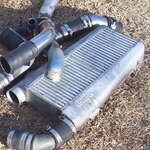DSM90AWD
DSM Wiseman
- 2,922
- 105
- Dec 22, 2002
-
Bear,
Delaware
Agreed, though my first test would have been a better compare since the JRC was rated at 1/2 the CFMs (650 vs 1100) and > 2x the pressure drop (2.5 vs <1) of the top-bottom.
Believe me when I say I'm suprised that such a "small" core has done as well as it has in my application. Then again, I'm not running rediculously high boost = heat levels (only 23-24psi) and the turbo I was using (T04E 50-Trim) is highly efficient, so the "capacity to cool" was well within the 1100cfm rating of the "small" core (actually was only using 1/2 of it's rated airflow capacity)
Would be interesting to take temp measurements on a side-side and top-bottom FMIC at various points after entry to the core to see at what point diminishing returns are seen to prove/disprove Corky's theory (e.g. the last 1/2 of the side-side does little to further cool). "In theory", since the side-side has 1/2 the cross flow area, the same airflow would travel at 2x the speed thru the side-side core vs the top-bottom. So would need to travel up to 2x more distance thru the core to have the same coolling as the top-bottom. This assumes 100% exposure of both cores to cooling air.
As I said before, I will test myself in practical terms to at least see what the difference is.
BTW.. I remember hearing that AMS was going to test a bunch of different style cores a few years back (much like the camshaft tests), but never heard any results
Believe me when I say I'm suprised that such a "small" core has done as well as it has in my application. Then again, I'm not running rediculously high boost = heat levels (only 23-24psi) and the turbo I was using (T04E 50-Trim) is highly efficient, so the "capacity to cool" was well within the 1100cfm rating of the "small" core (actually was only using 1/2 of it's rated airflow capacity)

Would be interesting to take temp measurements on a side-side and top-bottom FMIC at various points after entry to the core to see at what point diminishing returns are seen to prove/disprove Corky's theory (e.g. the last 1/2 of the side-side does little to further cool). "In theory", since the side-side has 1/2 the cross flow area, the same airflow would travel at 2x the speed thru the side-side core vs the top-bottom. So would need to travel up to 2x more distance thru the core to have the same coolling as the top-bottom. This assumes 100% exposure of both cores to cooling air.
As I said before, I will test myself in practical terms to at least see what the difference is.
BTW.. I remember hearing that AMS was going to test a bunch of different style cores a few years back (much like the camshaft tests), but never heard any results







 j/k
j/k













